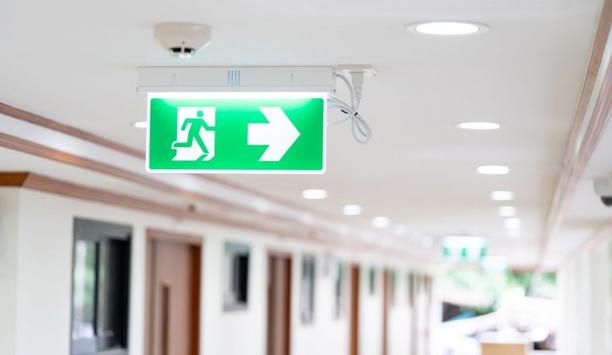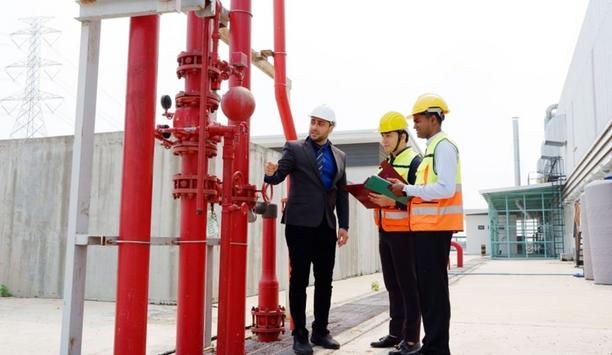Are people too passive when it comes to fire door safety? Research conducted by the British Woodworking Federation (BWF) in 2022 would suggest so, with a third of the British public stating they would not report a problem with a fire door, despite three-quarters of respondents believing a propped open fire door would not perform its role in the event of a fire.
From schools and shops to shared areas of employment and accommodation, people are habitually - and sometimes unknowingly - kept safe by passive fire protection systems such as fire doors and their hardware. Yet, in the same breath, occupants and visitors of busy public-facing buildings can be placed in danger by neglected or inappropriately used products. Highlighting these dangers, the Fire Door Inspection Scheme found 75% of inspected fire doors in the UK failed to meet required safety standards in 2021, for example.
Importance of fire extinguishers
Fast forward to the present day and perceptions are being challenged. Following a period of regulatory updates, greater focus is being placed on the responsibilities associated with both active and passive fire protection, and with a 79% rise in prosecutions related to fire safety violations between April 2023 and March 2024, it certainly pays to pay more attention.
Where most recognize the importance of fire extinguishers and smoke detectors, what more can be done to ensure fire doors and their hardware are held in the same regard?
 |
| Occupants and visitors of busy public-facing buildings can be placed in danger. |
Regulated and relied upon
Passive fire protection is identified as the group of structural measures designed to inhibit the spread of smoke and fire. Frequently hidden in plain sight and sometimes taken for granted, fire doors are a key element of any building’s passive fire safety system and should never fall under neglect. In fact, fire doors are often the first line of defence against fire and smoke, and when closed, will compartmentalize spaces to protect property and provide occupants with an opportunity to escape.
 |
| Fire doors are a key element of any building’s passive fire safety system. |
Such is their importance to public safety; fire doors are acknowledged by several professional bodies and are listed as a legal requirement in all non-domestic premises and houses in multiple occupations (HMOs). Under the recently updated Regulatory Reform (Fire Safety) Order 2005, a building’s designated Responsible Person (RP) must perform regular duties to review the condition of fire door systems, while providing residents with access to comprehensive fire safety information in the process.
Fire door hardware
Functional fire doors and clear exit routes are critical in ensuring appropriate precautions and preventative measures are in place and as such, responsible persons must recognize that a building’s fire doors will not perform as intended unless essential hardware has been correctly specified, installed, and maintained.
As correctly acknowledged by most of the British public, an open fire door is rendered useless in the event of a fire and to form an effective barrier against fire and smoke, fire doors must be capable of closing fully from an open position. When performing a closing action, a fire door will call upon its hinges, locks, latches and door-closing devices, and in the event of a fire, not one of these elements can fail. In view of this, fire door hardware is methodically designed and tested to support the integrity of fire doors. To meet necessary standards, a fire doorset must pass one or more of a series of standardized tests, confirming its UKCA and CE certifications and FD ratings. Users can identify a certified fire door by its label, usually found on the top edge of the door.
 |
| Functional fire doors and clear exit routes are critical in ensuring appropriate precautions. |
Shared responsibilities and results
As part of their research in 2022, the BWF found that almost half of those who neglect to report a problem with fire doors would not take action because they were unsure who to report it to, or cited it was simply not their place or role to report it. Seemingly then, in many cases, improved communication and education towards fire door safety can help mitigate risk and further raise standards across the built environment.
In any circumstance, people must continue being urged to keep buildings safe by reporting damaged or propped open fire doors to designated responsible persons. In higher-risk buildings where many rely on the same fire safety systems for example, it’s imperative that people know who they can turn to when a fire door safety issue arises, and often, this will be the landlord, owner, manager, or occupier of the premises. Equally, responsible persons must also adopt a hands-on approach by ensuring fire doors and their hardware are ‘subject to a suitable system of maintenance and are maintained in an efficient state, in efficient working order and in good repair’, as per the Regulatory Reform (Fire Safety) Order 2005.
 |
| Higher-risk buildings where many rely on the same fire safety systems. |
True purpose of fire doors
Where a fire alarm will inform you when something is wrong, fire doors require more proactive methods. As part of their ongoing maintenance duties, responsible persons should perform quarterly checks on fire doors, assessing the certification, gaps, seals, hinges and closing elements. Even durable door hardware can become worn and tired in high-footfall environments and may need repairing or replacing over time. An incorrectly installed or damaged self-closing device, for example, can limit the closing action of a fire door and prevent it from fully closing into the frame. Upon inspection, if a fire door isn’t operating as intended, it’s imperative to seek out professional advice and ensure maintenance or replacement is carried out quickly and professionally.
Whilst many of us use them day to day without thought, the true purpose of fire doors must remain clear at all times. Collectively, we must continue to change the perceptions associated with passive fire protection methods and fire door safety, and only when we improve collaboration and communication will we truly limit the devastation of fire. Simply put, there is a chain of responsible parties, and everyone must recognize what their role is - we all must do better.
 |
| Fire doors require more proactive methods. |
How Allegion UK can help
Allegion UK has a wealth of resources designed to help responsible persons, duty holders and professionals undertake product selection, installation and maintenance checks on fire doors and hardware.
For accessible fire door hardware support, Allegion’s new ‘Fire Door Hardware Fundamentals’ guide is available for download and combines expert guidance with helpful terminology and useful fire door safety checklists.



















